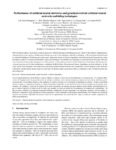
Please use this identifier to cite or link to this item:
http://ricaxcan.uaz.edu.mx/jspui/handle/20.500.11845/945| Title: | Performance of artificial neural networks and genetical evolved artificial neural networks unfolding techniques |
| Authors: | Ortíz Rodríguez, José Manuel Martínez Blanco, María del Rosario Vega Carrillo, Héctor René Gallego Díaz, Eduardo Lorente, Alfredo Mendez Villafañe, Roberto Los arcos Merino, José María Guerrero Araque, Jorge Enrique |
| Issue Date: | Feb-2011 |
| Publisher: | Sociedad Mexicana de Física, A.C. |
| Abstract: | Con el espectrómetro de esferas Bonner se puede obtener el espectro a través de un procedimiento de reconstrucci ón. Los métodos Montecarlo, de Regularización en, de parametrización, de mínimos cuadrados, de la máxima entropía son algunas de las técnicas utilizadas para la reconstrucción. En la ´ultima década, se han utilizado los métodos basados en la tecnología de Inteligencia Artificial. Se han desarrollado métodos basados en Algoritmos Genéticos y Redes Neuronales Artificiales en un intento de resolver las desventajas de las técnicas mencionadas. Sin embargo, a pesar de la ventajas de las redes neuronales, las mismas presentan algunos inconvenientes principalmente en lo que se refiere al proceso de diseño de de las redes, por ejemplo, la selección ´optima de los parámetros de arquitectura y aprendizaje. En a˜nos recientes, también se ha utilizado tecnologías híbridas, combinando las redes neuronales y los algoritmos genéticos. En ´este trabajo, se diseñaron y entrenaron varias topolog´eas de redes neuronales y redes neuronales evolucionadas geneticamente con el objetivo de reconstruir espectros de neutrones utilizando las tasas de conteo de un espectrómetro de esferas Bonner. Aquí se realiza un estudio comparativo de ambos procedimientos. |
| Description: | With the Bonner spheres spectrometer neutron spectrum is obtained through an unfolding procedure. Monte Carlo methods, Regularization, Parametrization, Least-squares, and Maximum Entropy are some of the techniques utilized for unfolding. In the last decade methods based on Artificial Intelligence Technology have been used. Approaches based on Genetic Algorithms and Artificial Neural Networks have been developed in order to overcome the drawbacks of previous techniques. Nevertheless the advantages of Artificial Neural Networks still it has some drawbacks mainly in the design process of the network, vg the optimum selection of the architectural and learning ANN parameters. In recent years the use of hybrid technologies, combining Artificial Neural Networks and Genetic Algorithms, has been utilized to. In this work, several ANN topologies were trained and tested using Artificial Neural Networks and Genetically Evolved Artificial Neural Networks in the aim to unfold neutron spectra using the count rates of a Bonner sphere spectrometer. Here, a comparative study of both procedures has been carried out. |
| URI: | http://ricaxcan.uaz.edu.mx/jspui/handle/20.500.11845/945 https://doi.org/10.48779/hnps-7x81 |
| ISSN: | 0035-001X |
| Other Identifiers: | info:eu-repo/semantics/publishedVersion |
| Appears in Collections: | *Documentos Académicos*-- UA Ciencias Nucleares |
Files in This Item:
| File | Description | Size | Format | |
|---|---|---|---|---|
| Performance of artificial.pdf | 1,1 MB | Adobe PDF |  View/Open |
This item is licensed under a Creative Commons License
